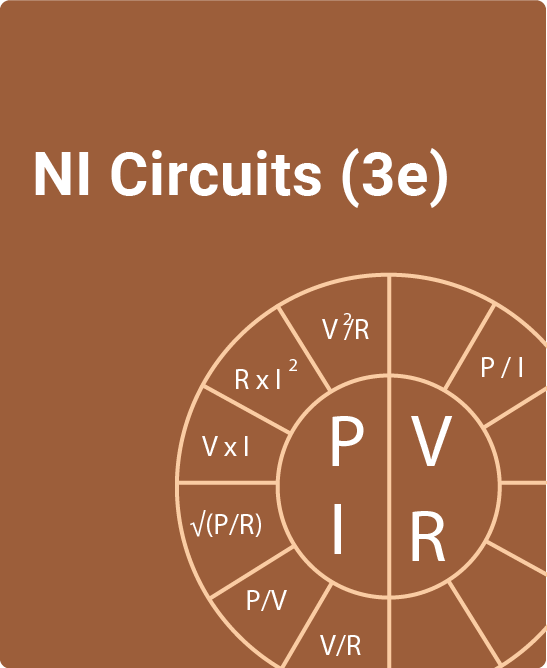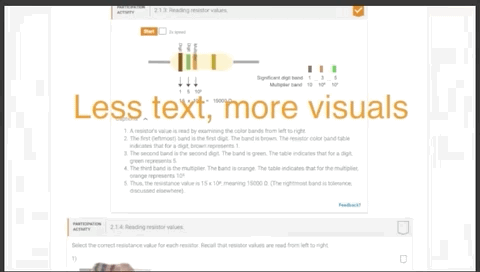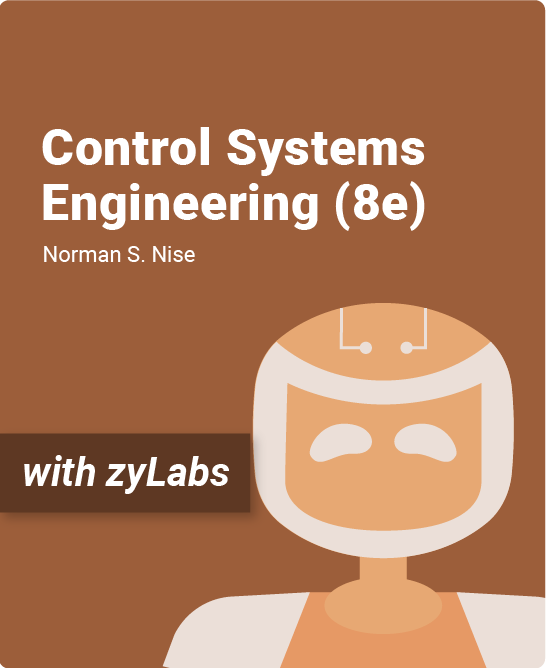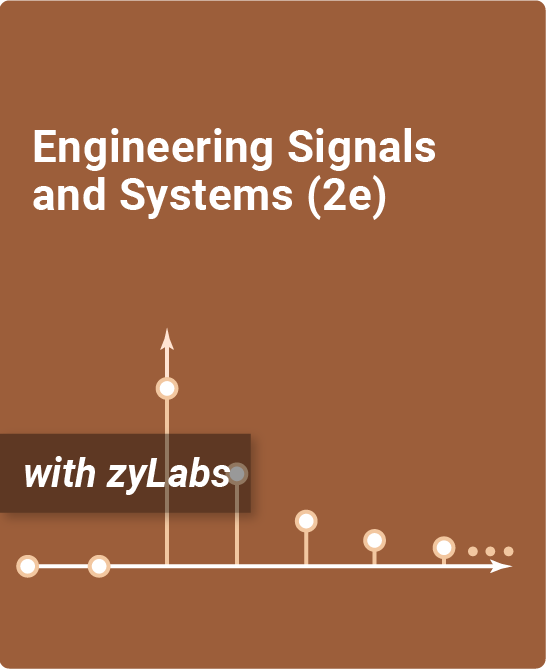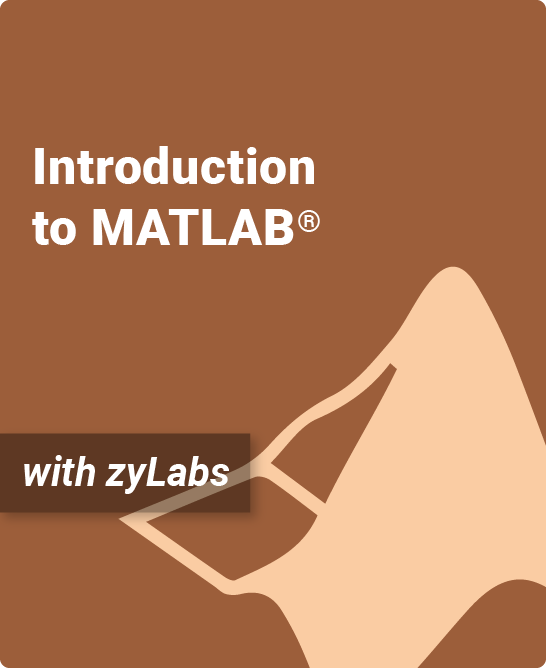Table of Contents
1. Circuit Terminology
1.1 Historical timeline
1.2 Units, dimensions, and notation
1.3 Technology brief: Micro- and nanotechnology
1.4 Circuit representation
1.5 Electric charge and current
1.6 Voltage
1.7 Measuring voltage and current
1.8 Power and energy
1.9 Technology brief: Voltage: How big is big?
1.10 Electrical safety
1.11 Voltage and current sources
1.12 Passive devices
2. Resistive Circuits
2.1 Ohm’s law
2.2 Resistors
2.3 Series and parallel resistors
2.4 Nonlinear resistance
2.5 Technology brief: Superconductivity
2.6 Kirchhoff’s current law
2.7 Kirchhoff’s voltage law
2.8 Series circuits
2.9 Parallel circuits
2.10 Series/parallel circuits
2.11 Source transformations
2.12 Technology brief: Resistive sensors
2.13 Wye-delta transformation
2.14 The Wheatstone bridge
2.15 Application note: Linear versus nonlinear resistance
2.16 Technology brief: Light-emitting diodes (LEDs)
2.17 Introducing Multisim
3. Analysis Techniques
3.1 Linear circuits
3.2 Node-voltage method
3.3 Supernodes
3.4 Mesh-current method
3.5 Supermeshes
3.6 Technology brief: Measurement of electrical properties of sea ice
3.7 Nodal analysis by inspection
3.8 Mesh analysis by inspection
3.9 Linear circuits and source superposition
3.10 Technology brief: integrated circuit fabrication process
3.11 Thévenin equivalent circuits
3.12 Norton equivalent circuits
3.13 Comparison of analysis methods
3.14 Maximum power transfer
3.15 Application note: Bipolar junction transistor (BJT)
3.16 Nodal analysis with Multisim
4. Operational Amplifiers
4.1 Op amp characteristics
4.2 Op amp comparators
4.3 Technology brief: Display technologies
4.4 Negative feedback
4.5 Ideal op amp model
4.6 Inverting amplifier
4.7 Inverting summing amplifiers
4.8 Noninverting summing amplifiers
4.9 Difference amplifier
4.10 Voltage follower/buffer
4.11 Op-amp signal-processing circuits
4.12 Instrumentation amplifier
4.13 Technology brief: Digital and analog
4.14 Digital-to-analog converters (DAC)
4.15 Technology brief: Circuit simulation software
4.16 Application note: Neural probes
4.17 Multisim for op amps and transistors
5. RC and RL First-Order Circuits
5.1 Nonperiodic waveforms
5.2 Capacitors
5.3 Series and parallel capacitors
5.4 Technology brief: Supercapacitors
5.5 Inductors
5.6 Series and parallel Inductors
5.7 RC natural response
5.8 RC forced response
5.9 RC Thévenin equivalents
5.10 Measuring the time constant
5.11 Response of the RL circuit
5.12 Technology brief: Hard disk drives (HDD)
5.13 RC integrator
5.14 RC differentiator
5.15 Other RC op amp circuits
5.16 Technology brief: Capacitive sensors
5.17 Application note: Parasitic capacitance and computer speed
5.18 Analyzing RC circuit transient responses with Multisim
6. RLC Circuits
6.1 Initial and final conditions
6.2 Introducing the series RLC circuit
6.3 Technology brief: Micromechanical sensors and actuators
6.4 Series RLC overdamped response
6.5 Series RLC critically damped response
6.6 Series RLC underdamped response
6.7 Summary of the series RLC circuit response
6.8 The parallel RLC circuit
6.9 Technology brief: RFID tags and antenna design
6.10 General solution for any second-order circuit with dc sources
6.11 Technology brief: Neural stimulation and recording
6.12 Multisim analysis of circuit response
7. ac Analysis
7.1 Sinusoidal signals
7.2 Review of complex algebra
7.3 Complex algebra in MATLAB
7.4 Technology brief: Touchscreens and active digitizers
7.5 Phasor domain
7.6 Phasor-domain analysis
7.7 Impedance transformations
7.8 Equivalent circuits
7.9 Component phasor diagrams
7.10 Circuit phasor diagrams
7.11 Phase-shift circuits
7.12 Phasor nodal analysis
7.13 Phasor mesh analysis
7.14 Phasor superposition and Thevenin techniques
7.15 Technology brief: Crystal oscillators
7.16 ac op-amp circuits
7.17 Op-amp frequency response
7.18 Op-amp phase shifter
7.19 Application note: Power-supply circuits
7.20 Multisim analysis of ac circuits
8. ac Power
8.1 Periodic waveforms
8.2 Average power
8.3 Technology brief: The electromagnetic spectrum
8.4 Complex power
8.5 The power factor
8.6 Power factor compensation
8.7 Maximum power transfer
8.8 Technology brief: Seeing without light
8.9 Measuring power with Multisim
9. Frequency Response of Circuits and Filters
9.1 The transfer function
9.2 Scaling
9.3 Technology brief: Noise-cancellation headphones
9.4 Decibels
9.5 Introduction to Bode plots
9.6 Bode plots, continued
9.7 RLC filters
9.8 Bandpass filters
9.9 Bandreject filters
9.10 RLC lowpass and highpass filters
9.11 Filter order
9.12 Technology brief: Spectral and spatial filtering
9.13 Active filters
9.14 Cascaded active filters
9.15 The MOSFET as a voltage-controlled current source
9.16 Technology brief: Electrical engineering and the audiophile
9.17 Application note: Modulation and the superheterodyne receiver
9.18 Spectral response with Multisim
9.19 Technology brief: Computer memory circuits
10. Three-Phase Circuits
10.1 Three-phase electricity
10.2 Source-load configurations
10.3 Y-Y configuration
10.4 Balanced networks
10.5 Unbalanced networks
10.6 Technology brief: Minaturized energy harvesting
10.7 Three phase power
10.8 Technology brief: Inside a power generating station
10.9 Three phase power-factor compensation
10.10 Power measurement in three-phase circuits
11. Magnetically Coupled Circuits
11.1 Magnetic coupling and transformers
11.2 Coupled inductors
11.3 Technology brief: Magnetic resonance imaging (MRI)
11.4 Transformers
11.5 Transformer equivalent circuits
11.6 Transformer energy
11.7 Ideal transformers
11.8 Autotransformers
11.9 Three-phase transformers
12. Circuit Analysis by Laplace Transform
12.1 Unit impulse function
12.2 The Laplace transform technique
12.3 Technology brief: 3-D TV
12.4 Laplace transform properties
12.5 Laplace transform pairs
12.6 Circuit analysis by Laplace transform
12.7 Partial fraction expansion
12.8 Partial fraction expansion, repeated poles
12.9 Partial fraction expansion using MATLAB
12.10 Technology brief: Mapping the entire world in 3-D
12.11 s-domain circuit element models
12.12 s-domain circuit analysis
12.13 Multisim analysis of circuits driven by nontrivial inputs
13. Fourier Analysis Technique
13.1 Fourier series analysis technique
13.2 Fourier series representation
13.3 Fourier series amplitude/phase representation
13.4 Fourier series symmetry considerations
13.5 Technology brief: Bandwidth, data rate, and communication
13.6 Fourier series circuit applications
13.7 Average power
13.8 Technology brief: Synthetic biology
13.9 Fourier transform
13.10 Technology brief: Brain-machine interfaces (BMI)
13.11 Fourier transform properties
13.12 Fourier transform pairs
13.13 Parseval’s theorem
13.14 Phasor vs. Fourier vs. Laplace
13.15 Circuit analysis with the Fourier transform
13.16 Multisim: Mixed-signal circuits and the Sigma-Delta modulator
14. Two-port networks
14.1 Two-port networks and impedance parameters
14.2 Admittance parameters
14.3 Hybrid parameters
14.4 Transmission parameters
14.5 Two-port parameter conversions
14.6 Connecting two-port networks
15. Appendix
15.1 Appendix A: Symbols, quantities, and units
15.2 Appendix B: Solving simultaneous equations
15.3 Appendix C: Links to Multisim information
15.4 Appendix D: Mathematical formulas
15.5 Appendix E: MATLAB
15.6 Appendix F: MyDAQ quick reference guide
Same Text, More Action
NI Circuits (3e) is the complete zyBooks version of the Circuits 3 textbook published by National Technology and Science Press that offers a highly-engaging interactive approach to learning circuit analysis and design.
- Approximately 100 dynamic animations provide insight into numerous topics
- Hundreds of new learning questions help students understand topics through incremental steps keeping students engaged and providing thorough explanations of both right and wrong answers
- Over 100 auto-generated and auto-graded Challenge Activities (“homework problems”)
- MATLAB scripts help model and graph circuit behavior
- Adopters have access to a test bank with questions for every chapter
New! Optional Challenge Activities
As an instructor, you now have the ability to mark Challenge Activities as optional, which means you can indicate which Challenge Activities your students need to complete in order to meet your course requirements. Those marked as optional won’t contribute to point totals in reports or assignments.
What is a zyVersion?
zyVersions are leading print titles converted and adapted to zyBooks’ interactive learning platform, allowing for a quick and easy transition to an engaging digital experience for instructors and students.
zyBooks’ web-native content helps students visualize concepts to learn faster and more effectively than with a traditional textbook.
This zyVersion of NI Circuits (3e) benefits both students and instructors:
- Instructor benefits
- Customize your course by reorganizing existing content, or adding your own content
- Continuous publication model updates your course with the latest content and technologies
- Robust reporting gives you insight into students’ progress, reading and participation
- Student benefits
- Learning questions and other content serve as an interactive form of reading and provide instant feedback
- Concepts come to life through extensive animations embedded into the interactive content
- Save chapters as PDFs to reference material at any time,
even after the course has been completed
Contributors:
Mark Atkins
Associate Professor of Electrical Engineering Technology/ Ivy Tech Community College
Nikitha Sambamurthy
Content Developer / zyBooks / Ph.D. Engineering Education / Purdue University
